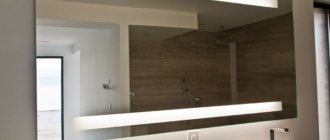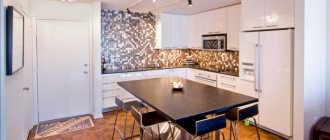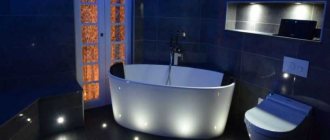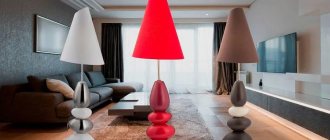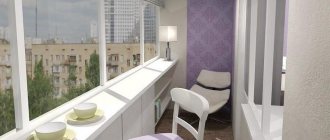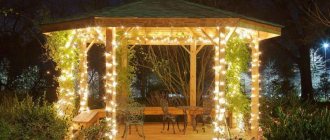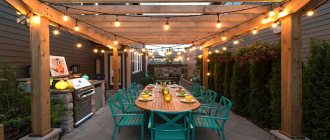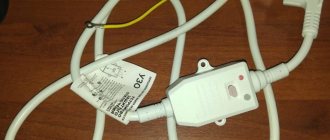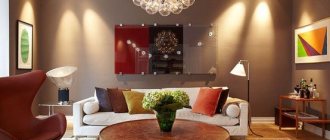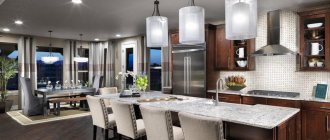Automation of all processes today is an integral part of technological progress. It allows us to make our lives much easier and more convenient. Let's consider the following issues related to the choice of sensors for the toilet:
- Ways to automate turning on lights in the bathroom and toilet Sound sensor
- Motion Sensor
- Presence sensor (infrared sensor)
The importance of lighting in the bathroom
When arranging a small bathroom, you should pay special attention to the issue of its lighting, because the right choice can also visually enlarge it. This can be seen in the photo of the lighting in the bathroom. With the help of lighting, it will be possible to create a microclimate in the room, which is extremely important, especially in the case of windowless bathrooms.
In bathrooms with limited space, daylight plays a special role. In a situation where there is no window in the bathroom, one solution would be, for example, to insert glass blocks into a wall facing another well-lit room.
If this option is not possible, it is very important that at least one of the light sources has a color similar to daylight.
There is a generally accepted rule that a bathroom should have at least two types of lighting. The function of general lighting is usually performed by a lamp located in the center of the ceiling. However, it is worth remembering that it should not hang too low, as this may limit freedom of movement and action in the room.
Worth remembering
- Light and smooth walls (ceilings) do not absorb light as much as, for example, dark ones with a rough textured surface.
- Fans of mirrors need to remember: to avoid the effect of multiple reflections, do not place them opposite each other.
- Plan ahead for lighting before renovations to run the cable.
- Don't forget about safety measures. Make sure there are no exposed wiring. If sockets are installed, they should be located away from washbasins and bathtubs (with moisture protection). Don't forget about grounding. Do not use extension cords or tees.
- When leaving the bathroom, don't forget to turn off the light!
Specifics of electrical wiring in the bathroom
Deciding how to arrange the lamps in the bathroom and what lighting devices will be used in the system is necessary at the preparatory stage before the renovation. Wiring in this room is carried out in a hidden way; the following is required:
- create an accurate cable routing diagram;
- choose wires taking into account the power of all electrical appliances;
- make a secure, reliable connection.
When installing electricity in the bathroom, aluminum and copper cables with a cross section of 4 mm and 2.5 mm are used, respectively. To determine the exact size for a specific room, the total power indicator is divided by 220. However, you should not make your own choice of consumables for the lighting system. It is better to entrust this work to a specialist who will do the wiring.
Example lighting system plan
Having an accurate layout of light sources allows you to drill walls and ceilings in the right places, lay cables along optimal routes, and ensure convenient use of lamps.
Presence sensor (infrared sensor) - main advantages and disadvantages, setup
A presence sensor in the toilet allows you to make the use of the room as convenient as possible; a switch is not required. This makes it possible to reduce the likelihood of electric shock and also save energy. The operating principle of this device is based on recording changes in the thermal background.
A lens system is located inside the sensor; it focuses IR radiation and directs it to a special highly sensitive sensor. When the radiation strength is sufficient, the sensor gives a command to turn on, and special switching contacts close. After triggering, they remain closed for some time, to prolong which there must be movement in the field of view of the sensor.
Setting up this device most often consists only of adjusting the duration of one actuation cycle, during which the contacts remain closed. Usually there is a special multi-position switch on the case; it can be used to adjust the timer.
This sensor has only one drawback - there is a high probability of false alarms. Since it can react to any thermal radiation - hot water or air conditioning. A device of this type has many advantages - you can very accurately adjust the angle, as well as the range of reaction to an object, its operation is absolutely harmless. You can place it anywhere on the ceiling absolutely unnoticeably.
What should be the lighting in the bathroom?
First of all, it is important to think through the installation scheme and evaluate the light distribution zones. There should be enough, but not too much: excessively bright rays will spoil the overall impression of the design.
You need to focus on:
- bathroom size and style;
- all main functional areas - they should be illuminated evenly;
- placement of lamps taking into account mirrors (bright glare can distort the reflection);
- additional lighting (place under the window sill, around the perimeter of the bath, at the sink);
- connecting light sources: it is better to do this in separate lines, so that the switches trigger different lamps, and not all at once.
The bathroom has several functional areas: a bath or shower, a sink with a mirror and a free area where you can change clothes and put things away. Sometimes designers offer options for illuminating shelves in a wall cabinet, and for a spacious room - cabinets, hangers and even full-fledged cabinets.
How much light do you need in the bathroom?
The ideal option for a bathroom is a sufficient amount of light, close to daylight. This way you can create the most natural light possible for a natural look and makeup application. Since a combined bathroom can be used for different needs, it is better to install a combined type of lighting in it.
For a small bathroom in a Khrushchev-era building, one central light in combination with two or three additional wall lamps is appropriate.
In a large room, it is advisable to install several overhead lighting devices. The greater the number of lamps, the smaller in size and power they should differ. For a spacious bathroom, zone lighting is suitable, thanks to which it will be possible to highlight individual functional areas, as well as emphasize the configuration of the space.
The following important factors influence the choice of lighting:
- Interior style and color palette. The darker the shade of the walls, the greater the intensity of the light sources.
- Size and shape of the bathroom.
- Features of zoning.
- Types of lamps, their maximum power and mounting method.
- The presence of reflective surfaces in the form of mirrors, tiles, etc.
First of all, before starting renovations in a room, they think through the light system and the specific places where its sources will be placed. They provide for cable wiring, construction of plasterboard false beams and other things.
Which light to choose?
Regardless of whether the bathroom is windowless or not, you should choose bright lighting that will not irritate the eyes. Warm light with a yellowish tint is considered the most comfortable and pleasant. This soft glow will promote complete relaxation in the bathing area. Devices with cool bluish light, located near the washbasin, will help you quickly wake up and invigorate.
This needs to be taken into account
For each specific room, the number and power of lamps will vary.
The following formula is usually accepted: 20 watts per 1 meter of area. For modern low-power (but no less bright) light bulbs, you need to make a correction by dividing the result by 5.
When determining the number and power of lamps, you should also use a small correction for the color of the walls of the room. Light walls scatter light better, which means you can install lamps of lower power (we multiply the result by 0.8). If the bathroom design involves dark colors, the estimated number of lamps should be multiplied by 1.5. The result increases by the same amount if the ceilings are higher than 3 m. Also, the ceiling covering imposes certain restrictions on the use of lamps. The most sensitive to heat are plastic panels and PVC film sheets, lath and fabric coverings are less susceptible, followed by plasterboard structures and concrete ceilings themselves. For the first two coatings, LED, fluorescent and low-power halogen bulbs are allowed. For the latter, you can use any light bulbs, but of course, not placing them closer than 10 cm to the surface.
A safe lighting system in the bathroom comes first!
Before you buy any lighting fixture, you need to read the IP marking. Let's look at the meaning of each number in detail:
- the first digit is an indicator of the level of protection against dust (maximum value – 6, full protection);
- the second digit is the indicator of protection against moisture (the maximum value is 8, allows you to immerse the device in water for a long time);
- the third digit is an indicator of impact resistance (maximum value - 10, absolute anti-vandal protection).
Decorative lighting
She may be:
in form and structure:
- point;
- linear;
- scattered - semi-hidden, for example, by the edge of a two-level ceiling.
by color:
- colored plain;
- changing color;
- with flickering and “winking” modes, like in New Year’s garlands.
The best-designed lighting system will not work fully if ventilation does not function well enough, if water vapor and dampness accumulate and remain for a long time.
Location Tips
If there is a lack of light flux in the room, a multi-tier lighting system with three levels is considered an ideal option.
Basics
Depending on the location, there are ceiling, wall and floor lighting fixtures with manual or automatic activation.
On a regular painted ceiling, pendant lights with increased protection against moisture are often installed. For a ceiling surface decorated with plasterboard construction, plastic panels or slats, built-in lamps are preferred. They are very convenient, aesthetically pleasing and safe, as they have hidden wiring. In the case of a stretched fabric, spot lighting is suitable, and for a multi-level ceiling, LED lamps will be appropriate.
A classic solution for small rooms is the placement of a central chandelier.
If ceiling lighting is not enough, wall light sources are used. The placement location is chosen depending on the height of the walls. Lamps should not dazzle the eyes, so they are usually installed at a level of two meters from the floor plane.
When purchasing sconces for the bathroom, pay attention to the lampshades; they should be shaped like a sphere or flask and be closed.
The photo shows the interior of a bathroom in the attic with spotlights built into the suspended ceiling.
Floor lighting is most often in the form of backlighting, such as LED strip lights or sealed fixtures. To create a peaceful atmosphere in the room, it is possible to use closed lanterns, translucent lamps or portholes. Built-in floor lamps will add an unusual ambience to the bathroom and add mystery to the atmosphere.
Dividing the room into zones
Installing light in the bathroom depends on many factors: the area of the room, the arrangement of furniture and plumbing, ceiling height, placement of mirrors, surface finishes, etc. All details need to be taken into account.
The bathroom will have 4 zones:
- Area above the bathtub and in the shower. The space is characterized by high humidity, accumulation of steam and condensation. Powerful lamps cannot be installed here. Lamps whose power does not exceed 10-12 W are suitable.
- An area located in close proximity to a sink, shower stall and other plumbing equipment. Since splashes of water and drops are possible here, it is not recommended to install powerful lighting. A safe option would be 20-24 W lamps.
- A space located at a distance of half a meter from plumbing fixtures no longer has restrictions on the power of installed lamps.
- The area further away is always dry. Any lighting fixtures are allowed to be installed here.
Such zoning does not depend on the presence of a hood in the room and is used in all rooms, regardless of their size.
Useful information on LED strips
This is an extremely convenient LED lighting option that is relatively inexpensive and easy to install. LED strips, also called LED strips, are polymer strips on which miniature LEDs with resistors are installed. The reverse side of the plank is usually equipped with an adhesive layer.
LED strip is a flexible plastic strip with LEDs installed on one side and an adhesive base on the other.
Installing such a tape is very simple: you need to glue the element in a suitable place and connect it to the power supply. The LED strip is divided into equal sections, each of which contains a certain number of LEDs connected in series.
The places for cutting this design have special markings. In bathrooms, only waterproof LED strips marked IP44 can be used. Such elements vary in power. There is a purely decorative option, and strong LEDs that provide a large amount of light.
Individual pieces of LED tape are connected using special waterproof connectors; cuts can be made strictly according to the markings applied by the manufacturer
There are single and multi-color LED strips. The latter have a slightly more complex structure: in addition to the general output, there are three more - one for each color.
When choosing an LED strip, you should take into account such an indicator as the density of LEDs, i.e. their number per meter. In addition, an adhesive layer is not always needed; there are designs without it.
Soldering of single-color strips of tape is soldered according to the “plus - minus” principle. When installing a multi-color tape, connect the areas indicated by the indices V+, G, R, B. To choose the right power supply and controller, you need to calculate the length of the tape and multiply this figure by the power of one meter.
Installing the LED strip is easy. To do this, you need to fix the tape and connect it to the power supply, controller and electrical network (+)
If the length of the structure exceeds 15 m, you will need to use another power supply, if the length is more than 30 m - two power supplies, etc. The connection of the network electrical wire is usually made to the contacts, which are designated as N and L. For multi-color tape, the controller is first installed.
If, when installing LED bath lighting with your own hands, you need to bend the tape, you should remember that the permissible bending diameter is 20 mm.
This type of lighting can be connected not only to a regular switch, but also to a dimmer for an LED strip. This device allows you to adjust the brightness of the LEDs. A portable remote control can be a convenient option for controlling the backlight.
When working with LED strip, you must strictly observe polarity, protect the structure from mechanical damage, and adhere to fire and electrical safety rules. If you intend to fix the tape on a metal base, you should first cover it with insulating material.
LED strip leaves wide scope for obtaining various effects when decorating the interior.
In addition to mirror illumination, it can be used:
- to decorate the ceiling around the perimeter;
- to effectively illuminate small shelves;
- for decorating a mirror;
- to visually highlight the bath;
- for arranging a false window, etc.
If you install LEDs under the bathtub, you can achieve the effect of the structure floating. A false window illuminated with an LED strip can become a stylish interior decoration and visually expand a small space. An interesting addition are luminous faucet and shower attachments.
If you place an LED strip at the bottom along the perimeter of the bath, you can achieve the effect of it floating. You can decorate other furnishings in a similar way.
Such elements are quite simple to install; they do not need to be connected to the electrical network. Of course, the listed techniques should be used sparingly so as not to spoil the appearance of the bathroom with unnecessary details. If there are too many elements, the backlight will simply merge into one unintelligible spot of light.
How to calculate lighting in the bathroom
The calculated parameter is brightness. It depends on what kind of lamp is used, as well as on its power. According to current standards, there must be at least 50 lumens (lm) per 1 m2. To better understand what a lumen is, let's imagine a stream of rays from a spiral under a glass shell. At a power of 100 W it is equal to 1300 lm. 25 W creates a flux of 200 lm. LED lamps are more efficient. With a power of 40 W or more they produce approximately 6000 lumens. This is three times more than fluorescent lamps, nine times more than halogen lamps.
To find out the required number of devices, you need to calculate how many lumens 1 W gives, and then determine how much power should be per 1 m2. The result obtained should be multiplied by the area of the room.
Suitable lighting power
The level of illumination in a sanitary room affects the comfort of the residents there. Therefore, there are standards for the number of lumens per square meter of a room, that is, for the brightness of the light flow of each light bulb.
For sanitary premises, 200 lumens per square meter is sufficient. At the same time, we must not forget about the decoration of the walls of the room: the darker the tone of the decoration, the more light will be needed for comfortable lighting.
- Incandescent lamps with a power of 25 to 100 watts have a brightness of 200 to 1350 lumens.
- Halogen lamps will provide brightness from 625 to 1170 lumens.
- Fluorescent lamps will provide 1500 to 2000 lumens.
- LED lamps are the brightest, up to 6000 lumens, and they can be selected to suit any need due to the many configurations of such lighting.
Illumination standards
Bathroom ceiling lighting
The simplest option is ceiling lighting. In traditional Soviet apartment design, lighting was a single lamp located in the center or above the entrance. If the room is small, this can still be considered the necessary minimum. But modern small chandeliers and built-in ceiling lamps will not take up much space, while making the use of the room more convenient.
Much depends on what you do in the bathroom: the functionality of the room is limited to hygiene procedures, or you like to read while immersed in water, or maybe this is where you get ready for work and clean yourself up in front of the mirror. You need to take into account the habits of all family members, think through possible scenarios and from here build a lighting scheme for everyone’s comfort.
Mirror and washbasin lighting
A classic technique in this area is installing sconces. Devices on the market are presented in different styles: classic, modern. The light of the lamps should be soft and diffused. In order to clearly see the reflection, a point light is more suitable.
The advantages of sconces include simple installation and operation. The lamps in them are easy to change. If necessary, the lamp can be moved. One of the disadvantages is the relatively large size. Devices visually reduce space and distort proportions.
Mirrors with built-in lighting save space and look modern and original. However, unlike removable decor, which is easy to remove or move, such lamps in the mirror cannot be dismantled.
External lamps are also small in size, and, as a rule, are installed in groups of 2-4 pieces at the sides. Manufacturers usually install them vertically or horizontally. Such devices are suitable for any bathroom interior.
Universal LED lighting is also used for mirrors. It consists of both point devices and LED strip. Some models have several modes: the control panel changes the color or intensity of the lamps. LEDs are energy efficient and easy to install.
There is also flexible neon - a hybrid of a classic lamp and LED lighting in the form of a strip. The PVC cord is equipped with diodes. It can be laid along walls and furniture. Installation on the floor or on a cornice is allowed.
A laconic option is to install lamps around the perimeter of the mirror. An accent on the top or bottom side also looks great.
Mirror and washbasin lighting
Depends on the overall style and design of the bathroom:
- Figured lamps on both sides of the mirror.
- Illumination around the perimeter, including the edges of the shelves and the lower border of the sink.
- Sometimes a large wall lamp in the center above the mirror and sink is enough.
Tinted, matte lampshades and the use of energy-saving lamps are recommended. The easiest way to select the lighting intensity is by experiment.
If anyone in the family uses contact lenses, good mirror lighting is vital. In this case, it can be considered mandatory to install two symmetrical lamps to the right and left of the mirror.
It is advisable to allocate a separate shelf or niche for a container with lenses and lens care products.
Bath or shower lighting
The same LEDs will help create a light accent in the shower or bath. The lamps are placed under a protective frame, so they are not afraid of water and temperature changes.
Additional lamps can be useful in a shower stall, especially if its walls are made of frosted, opaque glass, which does not transmit light well. When choosing colorful lamps, make sure they match the decor of the room. LED strips can be used to decorate any part of the room: thanks to their flexibility, they are glued to corners and rolled into shaped parts, creating a varied pattern.
Bath lighting
LEDs are universal decorative lighting that is used to decorate a bathroom or shower. Some manufacturers equip plumbing fixtures with glass elements with them. The lamps are located under a protective frame and are not damaged by water and temperature.
For a jacuzzi, the option with diode lamps is suitable: blue, yellow, purple. They can be combined with tiles of any shade. You can also equip a niche on the wall or an area under the bathroom with an LED strip. Thanks to its flexibility, it can be used to decorate shaped plumbing parts.
Expert opinionOlga KovalenkoSince 2010, I have been engaged in interior design and architectural design. The illumination of a faucet or shower head looks impressive - the water jets are painted in different colors. They change automatically or depending on the temperature.
Furniture lighting
Light is not only a decorative element - it improves the design of cabinets, etc. Niches and shelves can be decorated with white LED strip. As a rule, it is installed under the protruding parts.
Spot or strip LEDs can be mounted under a mirror or shelf. Here, two large models with a diameter of 5 cm or 3-4 small lamps are enough. In the same way, you can equip wall chests of drawers or side cabinets.
Furniture installed in a deep niche is also usually decorated with ribbon or LED spotlights on top. White, gold and blue colors go well with any interior.
Floor lighting
Floor lamps often come into contact with water and therefore must be moisture resistant. The required degree of protection is IP67. Devices with this index are isolated from liquid and dust.
You can decorate the floor with spotlights. To do this, holes are made in the marked areas of the tiles and lamps are installed in them. Most often they are mounted around the perimeter of the room or along one wall.
LEDs have a long service life and minimal energy consumption.
Neon lamps are expensive, but last up to 10 years. There are dozens of color variations of such lamps. But they must be hidden under a niche and isolated from water. It is recommended to install such lighting along the walls, in areas opposite to the taps.
A more modern analogue is energy-saving LED strips. They are easy to install, last longer and are less fragile. They are used both outside and as hidden lighting in the bathroom.
You can also install several small spotlights with white or blue color, or a thin LED strip in the steps. The lamp power should be no more than 5 W.
Styles and types of lamps
The following types of lamps are distinguished by location area:
- Sconces are wall fixtures of various shapes. They are produced in classic, oriental and modern styles.
- Spot - look good in a small bathroom. They are usually installed on the ceiling, in niches, corners or along walls, in the shape of a square, circle, wave, etc.
- Ceiling - large chandeliers in various style variations. They should have several lamps. But in a small bathroom, such lighting will visually reduce the height of the walls.
Types of lamps:
- The most common interior option is spotlighting in the bathroom. The main thing is to choose the right lamps. LEDs and RGB strips are the newest development at the moment. Their advantages include:
- the ability to use them in rooms with high humidity;
- variety of colors;
- this is the most energy-saving type of lamps - 60% more economical compared to alternatives;
- such lamps are environmentally friendly;
- service life declared by manufacturers is 10 years;
- many models are available with a control panel that changes the rhythm, color and intensity of the light.
- Halogen lamps. They have the following properties:
- bright light;
- low energy saving;
- direct, non-diffused lighting;
- cheapness;
- strength;
- instability to overvoltage.
The scope of application of halogen lamps is diverse: automotive industry, interior, street lighting, household appliances. For this reason, they are easy to find on sale.
- Incandescent lamps are the most common and versatile type of lighting and have been used in ceiling and wall fixtures for over 140 years. Characteristics:
- resistance to temperature and voltage changes;
- minimum energy consumption;
- safety - a broken incandescent lamp does not emit mercury vapor, like some types of similar devices.
Expert opinion
Olga Kovalenko
Since 2010 I have been engaged in interior design and architectural design.
Matte or tinted shades make the direct light of bright lamps soft and diffused.
Design techniques
Beauty is a subjective concept, but there are principles of harmony and consistency of details that are understandable to everyone on an intuitive level. For example, a huge chandelier will look bad in a small room. Don’t get too carried away with mixing styles and mixing classics and hi-tech. However, with good creative intuition, you can indulge in exquisite kitsch.
Focus on convenience
When decorating the interior, convenience should come first. A group of spotlights can be placed where they are needed. The devices must be positioned so that there are no shadows, observing the principles of uniformity and symmetry. Some designers advise focusing on some bright detail. The central lamp can also serve as such an element, but it is better to highlight an important element of the interior by directing rays at it or lighting it.
Take advantage of the layout
With a ceiling height of 3 m or more, you can use rays reflected from the walls and floor. To do this, lamps are mounted at the top of the wall, pointing down and slightly inward. If it is necessary to achieve softness and diffuseness, the devices are directed upward and hidden behind a wide baseboard or decorative casings to hide them from view.
Designate a work area near the sink
Particular attention should be paid to the work area near the sink. There shouldn't be any shadows here. If the rays are too bright, they will dazzle the eyes and create glare; if the intensity is insufficient, it will be difficult to carry out cosmetic procedures. It is better to make the lighting above the bathroom mirror as close to natural as possible so that it does not change the color of objects. It is most convenient to use sconces on flexible adjustable stands.
Podiums and steps can be decorated with LED strip - this will make them easier to notice. Using this technique, you can highlight any important element of the interior, not only from below, but also from above.
Connecting wires in the box
The wires in the box are connected according to the following diagram:
- Red or pink color is a phase.
- Blue or other – zero.
- If the wires are a different color, then the darker color is always selected as the phase.
The color of the power cable wires is taken according to the fact (as connected before).
Let's consider an example with a cable without grounding (if there is one, it is simply collected from all cables), where the red wire is the phase, the blue wire is zero.
From the supply cable, the phase goes to the switch (let’s assume the color is red from all switches), then after the switch it goes to the lamp (blue from the switch to the red lamp). All zeros (blue wires of the lamps and a similar color of the power cable) are connected into one twist. The cable to the socket is connected directly to the power cable.
Normal quality of twists is achieved if the length of the stripped core is about 6 cm. All wires in one twist are well twisted (by hand or pliers), then insulated - first with fabric thermal insulation tape, then with regular tape. After this, the twists are carefully distributed throughout the box, after which it is closed with a lid.
For convenience, you can hang tags from masking tape on the phase wires of lamps and incoming switches and write the name of the cable there with a pen or marker, so as not to get confused later. Then the lamps and switches (and the socket) are attached. When everything is ready, the electricity is checked - all lamps must be turned on with their own switches, and the outlet must also supply electricity. After this, the grooves are covered, and you can finish the walls, ceiling and floor.
If the walls are not plastered, then it is better to install socket boxes last.
Lighting in a small bathroom
For lighting in a small bathroom, it is not advisable to use too massive lamps and, if possible, do without a chandelier. Spotlights are best suited here, thanks to which you can also organize zoning and make the room as functional as possible.
The photo shows a small bathroom decorated with lighting and hanging ceiling lamps.
For a bathroom with a low ceiling, it would be better to choose lighting in the form of sconces, floor lamps or a ceiling chandelier with the light flux directed upward. This will create a play of shadows on the ceiling plane, which will visually add height to the room.
The photo shows a mirror with built-in lighting in the interior of a small bathroom.
Choosing suitable lamps - what you need to know
The number of lamps in the bathroom depends on the area. But even in the smallest bathroom, the minimum is two light sources on opposite walls. There is no maximum, since you can easily highlight:
- mirror on the sides;
- the lower part of the furniture and the bath itself;
- niche perimeter; a distant shelf or hanger.
A medium-sized bathroom will benefit if several lamps can be switched on in different orders, for example:
- for shower only;
- for cosmetic procedures;
- for preparation for and during washing;
- for meditation while lying in the bathroom (moderate, white or colored lighting is suitable).
Design examples
The illuminated shower head has a chic look, creating a colored stream of water. An equally unusual solution is a ceiling in the form of a starry sky or luminous drops with LED dot elements. To create original lighting, bathroom sides and podiums are decorated with backlighting, and niches, screens or baseboards are decorated with spotlights.
The photo shows a spacious bathroom with original lighting built into the floor.
To create a relaxing and surprisingly romantic atmosphere in the bathroom, it is appropriate to install LED bubble air panels.
Methods of mounting lamps
When choosing suitable lamps, focus not only on the designer’s intentions and the cost of the product, but also on their technical parameters.
Based on the method of fastening, they are divided into the following groups:
- Built-in. Spots and spotlights are mounted in a suspended ceiling using special lugs. For incandescent lamps the ceiling gap is 12 cm, and for halogen lamps it is approximately 7 cm.
- Hanging. For such models, you need a metal hook that is well secured to the main ceiling. As a rule, they are very decorative.
- Invoices. These are compact and lightweight devices, most often having the correct shape. For example, ceiling lamps. They are equipped with a base with special holes for installation using hardware.
Lamps can be very different, but their elegance does not depend on size, so even a small bathroom can be illuminated and decorated at the same time.
Ideas in various interior styles
In the classic style, the furnishings are decorated with steel or forged bronze candelabra and crystal products with numerous pendants, chains, beads and other decorative elements are used.
For minimalism, it is appropriate to use pendant lamps that have a simple shape and lack of decor. In the interior there are often models with round shades in the form of balls, cones or abstract lamps.
Provence is characterized by floor lamps, volumetric chandeliers and metal or wooden candelabra. To complement the beautiful interior composition, massive forged chandeliers with glass lampshades are selected and lamps or sconces in the shape of inflorescences are placed near the mirror.
The photo shows a lighting option for a bathroom decorated in a modern style.
LED lighting in combination with metal halogen lamps fits perfectly into the loft style. To enhance the industrial atmosphere, use pendant lamps on thick chains or cords that resemble wires.
Scandinavian interiors include any type of wall or ceiling lamps that can be combined with modern LED lamps. This style does not accept overly bulky and pretentious light sources.
Lamp placement levels
The photo of the light in the bathrooms shows three levels of placement of appliances. Lighting is installed in this room:
- top,
- average,
- lower.
Ceiling lights are necessary for the convenience of using the room. They create the main light and illuminate all areas. In the range of lighting products you can find options for a room of any size, taking into account the style and design features. Chandeliers and lampshades can be located on the upper level; spotlights can be used in the bathroom.
Ceiling lights create the main light
Mid-level lighting is called task lighting. This area contains light sources that provide comfort during procedures. For the most part, wall-mounted models are chosen for these purposes.
Mid-level lamps provide comfort during procedures
Lower light is not a necessary element to create proper comfort. This lighting is decorative, used to give the interior originality and create a special atmosphere. In addition, installing lamps in the lower zone allows you to perform visual correction, expand the room, and make it more spacious.
Bottom light creates a special atmosphere
Recommendations for choosing lamps
It is not so easy to choose the optimal light for the bathroom from a huge selection. Professional recommendations can help you in your search:
- When lighting a mirror, it is necessary to exclude unnatural images and shadows. There is no need to install a light source under the mirror or use colored lamps. The best option is a sconce with matte, white shades. The devices are installed on the sides.
- The bathing area may not be additionally illuminated. But if you want to create an atmosphere conducive to relaxation, you can hang a sconce over the bathroom and use lamps to illuminate the bottom. It must be taken into account that hanging lamps cannot be installed directly above the container. The latest generation of shower cabins have independent lighting.
Lighting the bathing area promotes relaxation
- Spot light in the bathroom can significantly increase the comfort and attractiveness of the interior. These elements are used for installation on the ceiling, walls, niches, steps, pedestals, etc. Installation of such light sources in furniture ensures ease of use.
- It is worth using floor lamps in the interior to provide the most cozy atmosphere. A good solution could be self-leveling floors with lighting and marine decor.
Floor lamp in the bathroom
- When choosing lamps, you need to take into account the color scheme of the interior. Light sources halogen, filament, LED, fluorescent can create a warm, cold glow in various shades. It is necessary to ensure consistency of tones, adjust the design if necessary, add warmth or coolness using lighting devices.
A competent choice of light sources and combinations of different types of devices will create maximum comfort and coziness.
Motion sensor (ultrasonic) - setup, advantages and disadvantages
Motion sensors, whose action is based on the analysis of emitted sound radiation, are the most convenient. Since the motion sensor in the toilet makes the light turn on as quickly as possible, there is no delay before the moment of switching (like a sound sensor).
A device of this type, like all other similar ones, is usually installed on a phase wire break. And when triggered, the power contact closes through a special relay. It can be located either inside the sensor or separately. Such switching devices are quite compact, and the motion sensor itself is very easy to hide in the bathroom. There are a large number of different modifications and types of housing on the market.
Inside the sensor there is an ultrasonic wave generator - most often it produces sound waves whose length is 20-60 kHz. They are reflected from various objects and recorded by the device. If a moving object appears in the radiation zone, the frequencies of the reflected sound wave change (Doppler effect). The device registers changes of this kind and closes the contacts.
An important advantage of such a device is its invisibility - it is extremely compact, it can even be placed on the ceiling of the room. Switching is carried out using a special relay; it can be located both inside the sensor housing and outside it. The disadvantages of this type of device include the fact that you won’t be able to sit quietly and “think” - you need to perform several movements as in the picture above.
Configuring the sensor is usually not required; to start its operation, you just need to apply voltage to it and connect the neutral wire.
Light in the bathroom: original ideas
In fact, even the most simple bathroom interior can be successfully enhanced using various lighting techniques. For example, you can create a special mood in a room using LED lamps and colorful ribbons. Some models of the latter change the shade of the glow automatically - over time, or when switching manually.
To make your bathroom design not only stylish, but also very practical, complement the glass shelves and the interior of cabinets and niches with small, neat lamps.
LED strip can be used to decorate shaped elements - the sides of a bathtub or sink, the contours of mirrors. This technique allows you to create weightlessness of objects in space.
An illuminated shower looks luxurious. The light source is placed in the shower head, causing the water stream to become colored.
We bring to your attention a photo selection of modern original lighting systems that will help you decide on the choice for the design of your own bathroom.
What type of lamp should I choose?
Today, the choice of lighting devices is so extensive that everyone can choose the option that best suits their wishes. So, according to the type of location on the surface, lamps can be:
- open;
- built- in This option is preferable for miniature bathrooms with not very high ceilings.
Depending on the location, the lamps can be:
- ceiling _ This is a timeless classic. Each bathroom should be equipped with at least one ceiling lamp, which will be responsible for the general light in the room;
- wall- mounted These are lamps that are designed to highlight certain functional areas of the room;
- floor lamps perform more of a decorative function; they can add zest to the interior of a room and visually expand the space of the room.
Each of the lamps used can perform one or several of the following functions:
- work lighting;
- decorative lighting;
- directional lighting;
- general lighting.
, different types of lamps can be used as light sources
- incandescent lamps;
- halogen;
- luminescent;
- LED
Everyone has the right to choose the type of lamps themselves, depending on the type of lamp or their own desire to save money, but special attention should be paid to LED lamps. They are considered the most economical and safe, because they do not heat up during operation. LED strip is also often used, which adds a real zest to the bathroom interior.
The only drawback of LED lamps is their high price.
Other bathroom lighting options
When choosing mirror lighting, you should also take a closer look at additional options. There are ready-made options on sale - mirrors with lighting. These are models that provide original decorative effects. In addition, you can organize spot lighting in the bathroom.
- Light systems with a switch are also an interesting option.
- This allows the lighting above the mirror to work independently of other lighting sources in the room.
- Illuminated mirrors with switches available in the sales offer are easy to install and do not cause any problems with utilities.
- However, you should consider purchasing them already at the stage of creating the initial design of the room.
- This will make it easier to hide cables and make these items more convenient for everyday use.
When creating mirror lighting, you should also pay attention to the color of the light.
- An LED wall light with neutral lighting works well here.
- It does not distort colors like sconces with warm or cool lighting.
Moreover, by choosing, for example, LED lighting for the bathroom in a suitable color, you can get an interesting decorative effect.
How to install lamps correctly?
When installing lamps in different types of ceilings, there are some features that should be taken into account. We'll talk about them.
Models for main ceiling
Ball-shaped lamps and dish lamps are what is chosen for the main ceiling. To secure it to a concrete ceiling, use the hardware supplied with the device. When attaching to a wooden ceiling, screws are suitable; they are used to secure the product through special working holes.
Even for a small room, you can choose a spectacular lamp for the main ceiling, and if you find a pair for it on the wall, it will be doubly wonderful
The sequence of work is simple: the power supply is turned off, the ends of the cable are stripped and connected to the terminals of the device, the clamp is fixed, the base is attached to the ceiling or wall, the light bulb is screwed in, the quality of the connection is checked, after which the decorative lampshade is fixed.
If the ceiling is plasterboard
The installation of gypsum boards in the bathroom is preceded by wiring for spotlights. It is advisable to use corrugated protection for wires. The ends of the wires leading to the holes for the lamps should not be less than 20 cm. The holes themselves are cut using a drill with a glass attachment. If holes are made before installing the sheet, you need to make sure that the lamp does not fall on the metal profile.
Spots for incandescent lamps are easy to install: the ends of the cable are secured to the terminals of the device, the ears of the spot are pressed to its center, and the spot is inserted into the hole in which it is automatically fixed. Installation of a lamp with halogen lamps also begins with connecting the cable to the terminals, then the device body is installed using spring fasteners, and the lamp is fixed in it with a special yoke included in the kit.
Working with electricity is always not only a responsible, but also a dangerous task. Never neglect safety rules
When working with surface-mounted lamps, first the strip is fixed with hardware, and then the supply wires are connected to the terminal. All wires are put into the hole, after which the housing is mounted. A heavy lamp should be secured with stiffening ribs. LED strips are connected to the network adapter. It is extended by soldering small sections, but not more than 15 meters. Before installation, degrease the surface, remove the protective film and lay the tape with light pressure.
Working with suspended ceilings
To fix lighting fixtures in a room with a suspended ceiling, you need to pre-mount a stand to the main ceiling and make holes in the finished canvas. These holes can be reinforced and protected with special yokes or thermal insulation rings.
This is a schematic view of the rather labor-intensive process of fixing the lamp in the case where a suspended ceiling is used in the bathroom
Please note the power, which should not exceed 40 W for incandescent lamps and 35 W for halogen lamps. It is best to use energy saving minions. Try to combine the safety of the ceiling and its aesthetic perception.
Photo of ideal lighting in the bathroom
Sources
- https://vannajakomnata.ru/osveshhenie-v-vannoj/
- https://yellowhome.ru/2018/11/05/optimalnyj-vybor-raspolozhenie-sveta-v-vannoj-komnate/
- https://realty.rbc.ru/news/60bdc5159a7947ea74242c7a
- https://design-homes.ru/komnaty/vannaya-komnata/398-osveshchenie-v-vannoj-komnate
- https://ratatum.com/osveshhenie-v-vannoj-komnate-idei-na-fot/
- https://giddesign.ru/osveshhenie-v-vannoj/
- https://www.ivd.ru/stroitelstvo-i-remont/osvesenie/osveshchenie-v-vannoj-komnate-sovmeshchaem-bezopasnost-i-estetiku-48201
- https://dekor.expert/vannaya/varianty-osveshheniya/
Varieties and characteristics
The ERA model is the most popular in our market. Let's look at it in more detail.
Other mechanisms and models with a timer from Vents, Ballu, Electrolux are connected in a similar way.
Here are the technical specifications and detailed data for all popular models:
Electrolux EAFM-100THERA SB D100 OptimaVents 100 KDomovent 100 CERA D 100 E 100SCBallu Green EnergyERA D 100 4C ETVents 100 Quiet
Connect directly
If you initially abandoned junction boxes and use recessed socket boxes for switching, then the third connection diagram will be similar, and the differences here are practically not noticeable.
It’s just that all connections are made directly in the socket box. It can be done by crimping or using the same Vago clamps, if space allows.
There are also expensive, sophisticated models with remote controls.
They are connected in two ways:
- directly from the distribution box - forced manual shutdown is performed by a button on the fan itself
- via a separate light switch button
